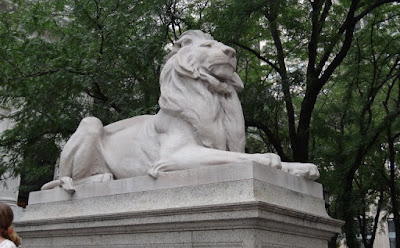The Lions of Fifth Avenue
Fiona Davis
Fiona Davis writes historical fiction and all the novels of hers that I've read so far have been set in New York City, each featuring a different iconic NYC building: The Barbizon Hotel for Women (in The Dollhouse), The Dakota Apartment Building, where John Lennon was shot (in The Address), Grand Central Railway Station (in The Masterpiece), the Chelsea Hotel (in The Chelsea Girls). I've enjoyed the way Davis incorporates specific features of each building in the plotlines, and have also relished the stories she tells featuring strong female characters.
So I've been looking forward to reading her newest novel, The Lions of Fifth Avenue since I first heard about it. If you are familiar with NYC at all, you may already know that the Lions refer to the giant statues situated near the front steps of the New York Public Library that welcome patrons and tourists from all over the world. Nicknamed by former Mayor LaGuardia during the 1920's Depression they have been since known as Patience and Fortitude.
The Library is only one part of the New York Public Library System, but it is a major feature of the city, taking up 2 city blocks on a prime location at 5th Avenue and 42nd Street. Built on the location and foundations of a former reservoir, it is lifted up from street level, giving it an imposing facade from every direction.
Before I started in on the novel, I googled the map to find its exact location, just east of Bryant Park and also searched for photos, both ex- and in-terior. Built in the Beaux-Arts style, the New York Public Library, opening in May 1911 after 9 years of construction, was the largest marble structure in the US at the time. The interior is just as impressive as the exterior, with many fine marble details, sculptures, stairways, woodwork, etc. Even the ceilings are extraordinary. The Rose Main Reading Room, on the 3rd level, has 52 ft ceilings and rests on 7 floors of metal stacks.
Since this Main Branch of the New York Public Library is for reference only, nothing may be removed from the premises and this is the feature that Fiona Davis built her story on. That, as well as the fact that when the library opened, there was an on-site apartment for the superintendent of the building and his family to live in, long since unused but providing a fascinating historical detail.
Using a dual timeline to tell the story Davis nicely links up the old and the new. There are lots of architectural details in this book as well as a good mystery with twists and turns that keep the reader turning pages. Readers will also enjoy the theme of women's rights which crops up in most Fiona Davis fiction.
I thoroughly enjoyed The Lions of Fifth Avenue and am keen to tour the Library in person someday.




No comments:
Post a Comment